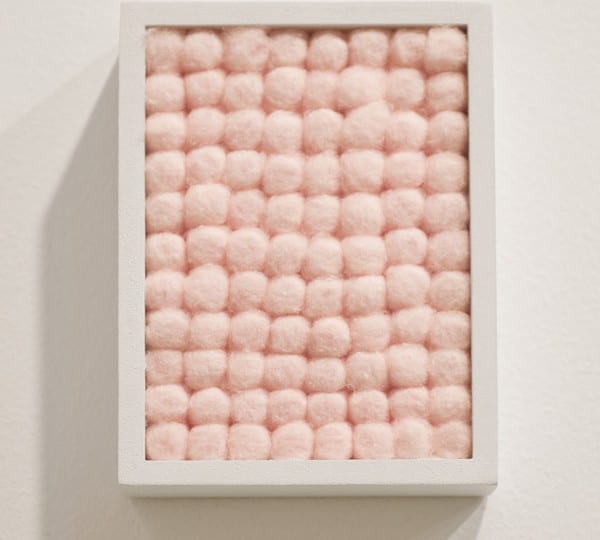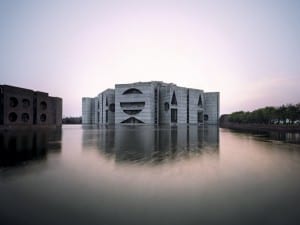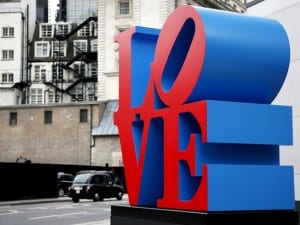There is an increasing noise building around the work of Dutch artist Sarah van Sonsbeeck. Though this should hardly be surprising since her work is fundamentally concerned with the texture of the sonic, the structures of the audible, and the mapping of sound itself. But while Sonsbeeck is sometimes described as a “sound artist”, there is a pertinent spatiality to her work that derives from her training as an architect at TUDelft. She later entered the Gerrit Rietveld Academy where teachers encouraged her to incorporate her architectural study into her work, something she was initially reticent of, but finding inspiration from other artists of the spatial, such as Rachel Whiteread and Gordon Matta Clark, she began to feel comfortable working in the idiom of both the spatial and the audible.
It is, in fact, via the late American artist Matta Clark and his Fake Estates – a project in which he acquired a number of tiny plots of land auctioned off by the city of New York – that Sonsbeeck explains her early work. Matta Clark’s acquisitions were of redundant utility (if they could even be found) meaning their existence was mostly in the mind, rather than in any physical presence. Sonsbeeck explains: “it seemed to me, if Matta Clark could gather a ‘mental estate’ from these slivers of unwanted land, there must be a ‘mental architecture’ also. An architecture determined by other than physical, material aspects, that was maybe even more real than the one I had been taught in Architecture school. I felt there should be a new class […] addressing all these immaterial aspects of architecture, like ownership of space, noise, silence, the view from your window”.
On emerging from art school her works were a playful exploration of this: in the project Letter to my Neigbours, Sonsbeeck calculated the percentage of her apartment that was intruded upon by her neighbours’ noise. She then contacted them to request their payment of 80% of her rent, since this was the proportion they occupied. While this work may appear to be a frivolous jibe at noisy neighbours, it in fact makes us aware of the numerous audio demarcations that were previously unheeded: traffic; birdcalls; shouts in the street. The outer edges of a noise mark a territory of impact, like church bells tolling time to the contained parish. By engaging with sound in this way, she lends it a spatial texture. In a nod to Whiteread, she copied the space under her chair “six times in varying intensities of day glow pigment mixed with resin and called it I never have the same thought twice”. These solidifications of what may be called “emptiness” can be challenging; as with Whiteread’s Houses, once the intangible is present in unapologetic density, we tingle with the recognition of the unfamiliar.
But these studies in shaping noise have developed into a wholly more challenging investigation: Sonsbeeck is now in pursuance of silence. These investigations still carry the stamp of the spatial and often delve into the architectural, but the definition is far from concrete: “The more I’m researching silence the less sure I feel what it exactly is […] It turned out to be a very psychological question, very similar to a Rorschach test. It really says much more of the person you are asking it […] than of silence itself”. Silence, it seems, is in the eye of the beholder. Acknowledging or trying to define our own silence is a process that makes us aware of our own limits and can offer an unsettling reflection. Sonsbeeck recalls experiencing an anechoic room (a completely soundproof room designed to also absorb any noise made within): “After a while you feel the silence pressing your ears, and you start to hear something faintly like a highway far off. Once I realized it was my own blood I ran out of the room.”
What emerges from Sonsbeeck’s work is the duplicitous nature of silence: both threatening and threatened it can stand for sanctuary and preservation on the one hand and stagnancy, censorship or lack on the other. Sonsbeeck’s 2009 work One cubic metre of broken silence illustrates this perfectly. Intended to represent a silence that once existed in a soon to be developed brown field site outside Almere, the cubic metre glass case was placed on site at counter to the environment it was, to some extent, preserving. Vandals soon damaged the work, but this was by no means an end for the piece. Sonsbeeck explains, “when I heard the news of the work being broken I was devastated, but when I saw it I instantly knew it was a better work because of it […] somehow now it truly showed silence as something very fleeting”.
Sonsbeeck’s pursuance of silence also has to contend with a modern obstacle: technology. Sonsbeeck, while being an avid user of Twitter, Instagram and other platforms, admits feeling that “something was lost” in their use. She sees the online world as “another type of public space” and so has typically gone about arranging this space, deciding what she does and doesn’t want to hear. This gave birth to The Faraday Bag: a simple shoulder bag made from silver-plated fabric that blocks electro magnetic signals. The concept has even greater implications: Sonsbeeck is now working on the ‘antidrone tent’, a small construction of emergency blankets that blocks thermal infrared sensing, making it invisible to drones (to be shown in her solo exhibition at the Nederlandsche Bank, later this year). It seems her art is in constant dialogue with emerging technologies, trying to retain slivers of silence, as Matta Clark maintained slivers of ‘no mans land’. But while Matta Clark’s strips of tarmac are surveying offcuts and neglected fragments of blueprints, Sonsbeeck’s kernels of silence seem to be produced as preservation. However, this is not the limit of her work. By capturing and exploring sound and silence, Sonsbeeck maps the edges of our interactions and offers a refreshing evaluation of modern space. Her work is about how to position oneself in a world that is home to a variety of sounds and how, when we understand our own definitions of silence, we can hear ourselves all the better.
For more info on Sonsbeeck visit www.sarahvansonsbeeck.com.
Lyndon Ashmore
Credits
Sarah Van Sonsbeeck courtesy of the artist.
1. Courtesy of the Annet Gelink gallery.
2. Silence is Golden But This is No Silence, photo Stefan Sturm.





